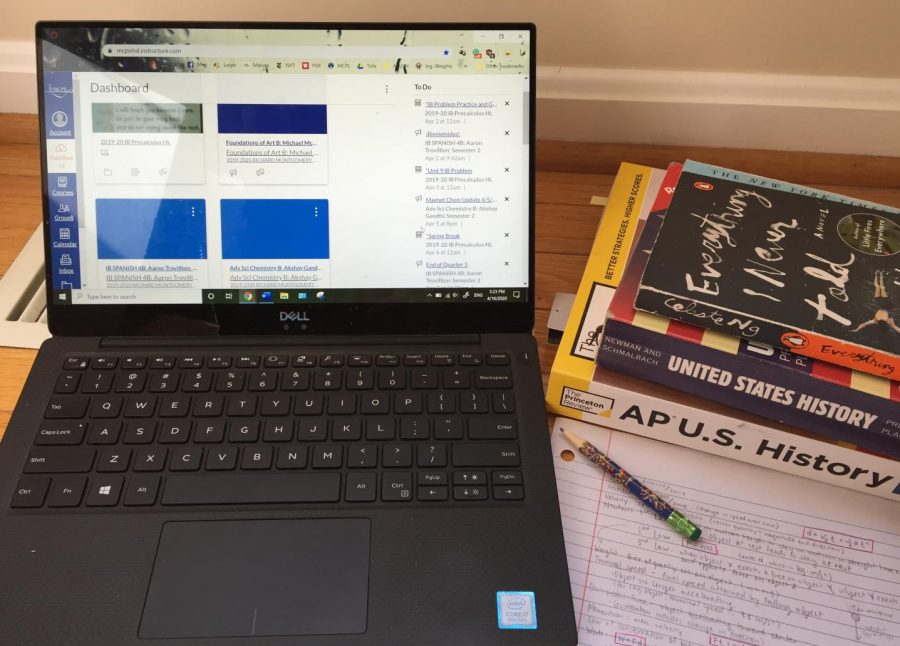Your donation will support the student journalists of The Tide, Richard Montgomery High School's student newspaper. Your contribution will allow us to purchase equipment and cover our annual website hosting costs.
Students and teachers adapt to distance learning
April 16, 2020
Since March 30, RM students and teachers have been engaged in distance learning. Though Maryland schools are scheduled to reopen on April 24, it is likely that the school closure will be extended.
As the coronavirus pandemic continues to rage on, schools across the country have taken the leap into online learning. RM is no exception, and with the third week of distance learning about to wrap up, students and teachers have encountered many ups and downs in getting used to this new experience.
With “school” now taking place at home, some students and teachers have found it difficult to strike the right balance between the two. When there is a physical separation between school and home, it can be easier to temporarily put aside one’s home life psychologically and focus on the work that needs to be completed. But now, the distractions found at home are much harder to ignore, and unexpected interruptions have become a regular occurrence. “Life now, everything seems to be happening in just short bursts of time,” English teacher Jeremy Koenig said during a video call.
Although teachers have designated office hours during the week to maintain some semblance of a regular school schedule, time management and motivation has still been a challenge for many students. “It’s not like we’re physically there, so it’s definitely more difficult to get into a working mindset,” senior Cathy Yung said during a video call.
On the other hand, some students have found that the flexibility of having all their schoolwork and classes online has actually helped them plan their time more effectively. “Since everything is online, you actually can keep track of like, oh this is what I have to do. I’ve actually forced myself to make a whole schedule of all my seven classes and everything’s that’s due,” sophomore Carolyn Lee said during a video call.
Even with the right amount of focus and motivation, one thing noticeably lacking in the distance learning experience is interactions with other people. Studying with, or even simply around, other people can make the learning experience significantly more rewarding. Seeking out help or guidance from a teacher has also become a much slower process, as students must rely on email or the designated office hours to have their questions answered.
Despite all the challenges that students and teachers have faced with online learning, many have still seen some positive effects to come out of it. Because office hours begin at noon rather than the 7:45 a.m. start time of a regular school day, many students have been able to wake up later and still complete all the work required for their classes. Some have also found more time for hobbies and other pursuits besides schoolwork that they otherwise would not have had time to do. “You do a lot more stuff that you usually don’t do, so that’s great,” Yung said.
In addition, math teacher Laura Goetz said during a video call that this period of distance learning could show teachers that remote teaching is a feasible option during future unexpected circumstances. In the past, Mrs. Goetz has created videos for her students to watch on snow days so that she does not fall behind on what needs to be taught in the curriculum.
However, Mrs. Goetz added that this current experiment in online learning may also show others that it is not a magic bullet. Although online learning has sometimes been touted as the future of education, confusion about what time classes are taking place, unclarity about what assignments are due and various other technical difficulties, such as audio and video mishaps during Zoom calls, are unavoidable.
Religiously checking the numerous platforms that different teachers are using, including email, myMCPS Classroom and Google Classroom, has also become a necessity for students. “If you don’t check your email, or if you just missed the email, you literally miss the entire class,” Yung said.
This period of remote learning has also led some teachers to question whether all the aspects of a normal class period are absolutely essential, even during a regular school day, or are simply done because the luxury of time is available. Many have also had to adjust and condense their lesson plans in the face of the transition to distance learning. “There’s a lot of deep thinking about what are we teaching? Why are we teaching it? You know, what does the regular school day look like? Will the times we’re in now seek to recreate that? Or will this be taken as an opportunity to sort of reinvent the way that learning happens?” Mr. Koenig said.
It goes without saying that many students and teachers look forward to returning to face-to-face learning and teaching. Although RM is slowly adapting to this new digital form of learning, no amount of Zoom meetings can replace the in-person interactions that are only found within the brick walls of the school building. Even the smallest moments are missed. “You know, those down moments and the conversations with colleagues, the daily contact … I miss that the most. That’s what’s been most hard—just seeing you all and being in that space together,” Mr. Koenig said.

